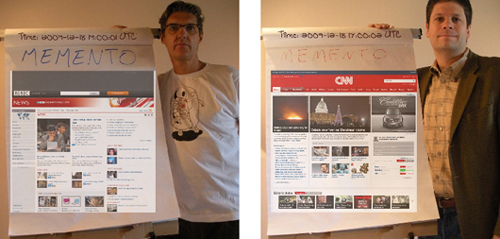December 28, 2009 -- What if you could activate a time machine right in your web browser and explore content from a date in the past? Herbert Van de Sompel of the Los Alamos National Laboratory and Michael Nelson from Old Dominion University discussed this when they visited the Library of Congress on November 16, 2009, to talk about their newest project, Memento (external link). A webcast of the presentation is available.

Herbert Van de Sompel (l) of the Los Alamos National Laboratory and Michael Nelson (r) from Old Dominion University.
The term Memento refers to an archival record of a resource as well as the technological framework that supports the ability to discover and browse older versions of Web resources. Nelson said that "Memento will allow the holdings of content management systems and various archives to be integrated, creating a 'long tail' for archives."
The Memento framework leverages existing capabilities and protocols of the web and applies them in a novel way to add a time-based dimension to searching and browsing. The result is a system in which archived resources can seamlessly be reached via the universal resource identifier of any current resource.
This is not possible today because current and older web content are nonintegrated. There are some archived resources available, but they are limited in scope and accessibility.
"In Memento you always go back to the original resource, but you end up at an archive," said Van de Sompel. He noted that it is cumbersome to navigate the past even when the archival resources are available.
The Memento framework works to address this situation in two ways. Memento researchers have first proposed an additional Hypertext Transfer Protocol (external link) header (external link), X-Accept-Datetime, that allows Web clients to negotiate with a Web resource by specifying the date and time of the archived version they would like to retrieve for the resource.
Following on from this, the researchers realized that a multi-archive view was necessary to ensure that the user would be able to receive the archived version closest in time to the expressed date preference. To that end, they’ve proposed an application programming interface (external link) (API) that will create gateways to available archived versions for any specific original resource across a range of archives.
The Memento research is still in an early phase, but there has already been much interest from the web archiving community, including a commitment from the Internet Archive to deploy the Memento protocol in early 2010.
In addition to refining the core framework activities, future work of the project includes the development of a Firefox browser plugin to make it easy to explore archival resources.
The possibilities of Memento are exciting. "The navigation space that results from our proposal is not like the live Web itself," Van de Sompel noted, "it is the Web itself, as regular navigation and time travel are integrated. Time travel can be ours."
